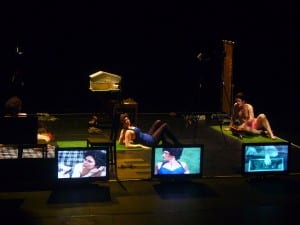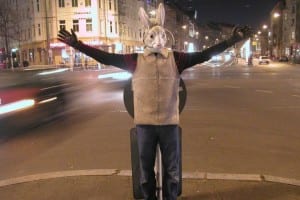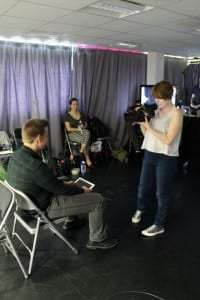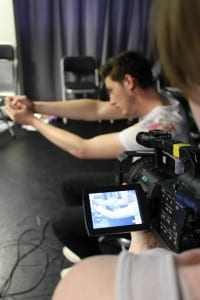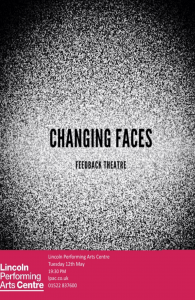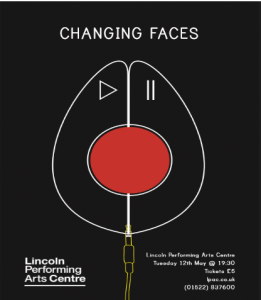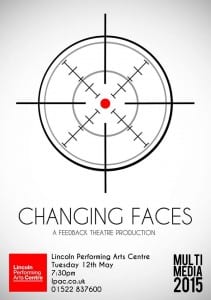The Lessons
During lesson one of the multimedia module the group experimented with notions of perspective, using Cameras and projectors the performers began to experiment with camera angles and manipulating images to create a projected image on the screen. Naturally in order to do this lesson we were required to become accustomed to not only using the cameras effectively, but how to correctly use the equipment we went on to use throughout the process of creating the performance. During the first lesson of the module the group was taught key terms in aspect to multimedia performance, one of which was intermediality, the idea of multiple mediated platforms working in harmony together to create a piece. Philip Auslander claims that film and theatre “can work together as equal partners” (Auslander, 2008, 3) this is the theory from the first lesson which went on to influence our performance, this opinion is what influenced our performance to use media in the way it did. We decided as an ensemble that the mediatised elements of the piece should not be seen as the whole performance, but as equal to theatre and as such we would use the media to enhance the effect of our piece.
Virtuoso (Working Title) Image Courtesy of: http://multimediaperformance2014.blogs.lincoln.ac.uk/tag/virtuoso-working-title/
We then went on to study Proto-type Theatre’s Virtuoso (Working Title) a piece that explores notions of identity through fragmented narratives between the three character, playing a kind of game which involves the characters taking on multiple roles of famous people throughout history, but constantly making references to holes and windows, exploring the notions of escape and freedom. The fragmented nature of the piece mirrored the fragmented mind-set of the characters themselves, their inability to create a complete image of who they are, constantly attempting to be someone else other than themselves. The fragmented nature of Virtuoso (Working Title) had a large effect on the final performance of the ensemble, they decided that their piece Changing Faces would work better if it were fragmented, a way of letting the audience decipher the piece rather than us spoon-feeding them as it were, as Petralia states, “When the brain is presented with more complex situations, or ones where there is no immediately apparent way of understanding, the brain goes through a process by which every possible outcome/answer is presented as equally correct” (Petralia, 2012, 162) which was the desired effect of Changing Faces.
Supernightshot Image Courtesy of: http://www.gobsquad.com/projects/super-night-shot
The group then watched a version of Gob Squad’s Supernightshot, a performance which involves the theme of making the everyday extraordinary. The piece makes the audience question their own humanity through showing them an extraordinary story through four screens which show the audiences home, things they see every day and take for granted. Lavender claims that “Intermedial performances are increasingly hybrid in form, and entail (simultaneously) fragmentation and synthesis” (Lavender, 2012, 123) which is true for Supernightshot and led the group to create a piece around similar ideals, showing the humanity behind the characters in history that we judge through their actions, taking no time to think about a family they may have had, or the everyday things they may have done. Not only this but Supernightshot also inspired the group into the technique of pre-recorded footage, rather think the piece having to be all live action as traditional theatre would suggest. We used the notions of pre-recorded footage in both the Columbine scene and the Anne Frank scene which both used modern technology in the form of a GoPro camera and pre-recorded a massacre in the Columbine scene and a chase between the Nazi’s and Anne Frank. This not only enhanced the effects behind the two scenes, but also helped to enhance our theme of things that we do not see in life, by showing the backstairs and basement area of the performance space we were able to relay our message of seeing things that we do not see from just what we have in front of us.
The lessons that led up to the creation of Changing Faces were vital in the creation of the piece itself, throughout the module we learned from other multimedia performances and took influence from their themes and ideals. Not only this but without the prior lessons we would not have been inspired on different ways in which the media can be used to enhance a performance and in ways that do not distract from the performance but rather work alongside the performance in harmony to create an intricate, stylised and powerful performance.
The Process
Changing Faces was a performance that was very slow in its creation and passed through many obstacles in its inception. There were issues with the amount of ideas that we had as we were attempting to ground a concrete idea for the performance, issues with miscommunication between the ensemble and the directors and issues of misunderstanding of roles. Despite these setbacks as a group towards the end of the process we really came together, perhaps a little too late, but we came together nonetheless and created a performance which was described as exciting, interesting and powerful by audience members who attended the performance. Despite these issues it is not to be thought that the group did not work hard enough through the process as this is not true, we were merely to indecisive it a concrete direction for our piece.
The G.O.D
Initially the ensemble decided to follow the idea of oppression throughout history and how we could incorporate the idea of oppression into our piece. We decided that the best way to proceed would be to create a 1984-esque performance, a dystopian allegory which explores the idea of oppression through the media. Oppression in the news, its biases and allegiances, oppression by CCTV, oppression by government. We created the G.O.D a fictional dictatorial government which would have been in power for many years prior to our show. The idea was to tell several stories from both sides, ultimately leading to the G.O.D leader being technology itself, the physical self is feared but after all the story the most powerful thing in the performance is the technology itself. The intention of the piece was to portray the message of the oppression from a different angle, using an excess, an overload of technology, the group wanted to not only comment on the idea of oppression from man to man, but also the oppression we seem to willingly accept, our oppression and obsession with technology, how the progression of technology is linear to our species becoming more and more technology obsessed. This was an idea that the ensemble created a lot of material for, but due to poor communication between roles and individual it was deemed that we did not have enough material to create a performance from this idea, despite many members had done a lot of work for this idea. As such suddenly the focus was on to another idea completely, which irritated many members of the group and led to friction, further reducing the work ethic of the ensemble with the performance date drawing ever closer.
Dark Thoughts
One idea that stemmed from the G.O.D idea was the documenting individuals scene, but rather than them describe their oppression, the performers would instead retell dark thoughts that they have had, no matter how dark the performer would not move, the action would be pre-recorded video of the characters stood still whilst a pre-recorded voice is played over the footage. This idea took up a couple of weeks of the process time we had after the modules scheduled lessons, this idea seemed to irritate the cast in some way as this piece seemed to be a step back from the G.O.D idea in its detail and material gathered for the idea. Also this friction had something to do with the nature of this idea. The directors chose to ask the cast for their input on how the piece should take place and how they wanted it to be created, the majority of the cast requested a piece with a linear narrative, but this seemed to be ignored when the performers were told that the performance would definitely be fragmented. But the cast did not feel they could get enough material from this idea and then changed the piece itself.
Final Performance
Despite the slow start of the process, when the group had finally established a grounding from which to develop work, the process ran noticeably more smoothly. The idea for Changing Faces arose when a cast member broke loose of the director/performer boundary and decided it was time to take charge and organise the mess that had been created. The member showed a video of Marilyn Munroe’s ‘Happy Birthday’ speech she delivered to the president of the United States John F. Kennedy, to which she was late due to a suspected case of drug abuse. As was pointed out only a select few know the actual reason for why she was late to the ceremony, but if we could have changed the perspective of the recording to backstage into the dressing room, we would have been able to see the facts behind this iconic moment in history, from this Changing Faces was created. The group decided that to speed up the process we would all select a moment from history and retell it, or reimagine it in a different light, directing our own scenes and choosing our own cast for each scene the performers quickly began to gather research for their chosen field of study and as the process progressed, so did the scenes.
Images from Columbine scene.
Columbine
This is the section Charlotte and I co-directed. The Columbine scene is inspired by the shootings at Columbine High School in Colorado where Eric Harris and Dylan Klebold entered their own high school with the sole intent of massacre. We began by researching the topic, when it happened, where it happened, interviews with the survivors. Through this we found this quote “Klebold was hurting inside while Harris wanted to hurt people” (Cullen, 2004) which led us to forget them as murderers and think of the two boys as humans, trying to locate anything that would show the humanity of the characters were trying to portray, after some searching we found journal entries from both Dylan and Eric supporting the theory that one was hurting and one wanted to hurt. Eric’s journal which was read aloud by one performer included “and i WILL be armed to the fuckin teeth and i WILL shoot to kill and i WILL fucking KILL EVERYTHING” (Harris, Date Unknown) this clearly shows the aggressive side of Eric and most definitely shows his desire to kill. On the other hand Klebold’s journals are far more deep and filled with self-doubt, “My existence is shit. To me- how i feel that i am in eternal suffering. In infinite directions in infinite realities.” (Klebold, Date Unknown) this showed the humanity behind the history but as directors we wanted to go further. We utilized the camera’s in a way that focused on the performer getting ready for the massacre, preparing his gun and the propane bomb which was intended to kill over 600 pupils in the cafeteria area of Columbine, whilst the other character used a Playstation One controller (the console of choice for Eric) and acted out playing a video-game, when the footage he was watching was recorded material from Columbine cafeteria itself. The gaming element of the scene was a direct reference to the argument that has surrounded violent video-games and still goes on today; do they influence people to become violent? Through study we found that in Eric’s journal he makes reference to one such video-game- Doom- and as such we used the opening sequence from Doom to begin the scene. The video-game element to the piece was further enhanced when we discovered that prior to Columbine violent video-games were from the P.O.V of the gun, as such we brought an utilised a GoPro camera and attached it to a gun whilst pointing at the audience, mimicking the boys attempts to appear ‘cool’ during the massacre, during which a mist machine was utilised to represent the bomb going off in the canteen, whilst the bomb was actually going off on the CCTV footage, making the audience feel like the victims of the massacre. We then cut the screens to a pre-recorded video of the two performers walking backstage (as an attempt to stick to the original them of seeing things we do not see) through dead bodies with the video ending with the gun in one performers mouth and the screens playing a “Game Over” sequence. The costumes used were also collected (as were the majority of the costumes for the entire show) by Charlotte and I, they were exact copies of the ‘Trench Coat Mafia’ the boys claimed to be in, with the real outfits resembling that of a violent movie The Matrix. The Columbine scene, in my opinion, was a great success, it utilised a vast array of media devices as well as adhering to the themes we were given, many people who were questioned post-show claimed it was their favourite scene and highlighted the intricate use of technology, costume and props.
Reflections
Despite a slow start I believe that the show was a success, that being said it would not be right to claim it was perfect and there are many things about the show I would change. If I could start the whole process over I would definitely have taken a position of greater power, too often were friendships getting in the way of organisation, powerful cast members feared telling a friend that they were not pulling their weight. This may be a reason as to why Charlotte and I had to spend over £800 between us on props and costume the week before the show.
Secondly I would have banned phones and other devices (unless necessary) from the rehearsals, do not read this as me claiming I was not one of the cast members occasionally on my phone, because we all as a cast were guilty, but when members of the cast who are supposed to be in power are on their phones during rehearsals rather than doing their job and having an input on the show, it is easy to see why our performance was so disorganised even when we got to the performance day itself.
Shaw claims that “The single biggest problem in communication is the illusion that it has taken place.” (Shaw, 1969) and unfortunately this was the case in our piece. Far too many times were actors cut from scenes without actually being told they had been, far too many times were transitions changed without it being communicated to the cast and when the day before the show you are cut from a scene and almost walk on in the tech run, it is clear that there were fundamental issues of communication between actors and the people in power.
Finally issues arise in the theme behind the piece, the main issue with our piece is ‘what’s the point?’ and this is where our piece failed. When shortly after the show the directors were essentially asked this question and they could not answer, you have to accept there was a fundamental flaw with your performance. Almost a month prior to the performance I suggested a running narrative between the fragmented scenes, rather like the doll’s house in Virtuoso (Working Title), to add meaning to the piece, this was also suggested by our lecturer the day before the show but unfortunately myself and the lecturer were both ignored. Personally I believe the theme of our piece should have been to give history humanity, as scenes like Columbine, Coronation and Assassin all did to great effect, then the running narrative could have been as simple as a member of the cast reading facts from a history book, contrasted with the humanity behind the history.
Naturally all this negativity may seem like I despised the show, which is not the case, I merely felt that it had the potential to be far greater. If the ensemble were more organised, correctly led and more enthusiastic about the piece I believe the show would have been more successful.
Marketing Materials
As marketing manager I mass-produced and co-distributed material designed by Connor McCue and Jack Tulin to help market Changing Faces.
Works Cited-
Auslander, P. (2008) Liveness, Mediatization, and Intermedial Performance. In Liveness: Performance in a Mediatized Culture. 2nd Ed, New York: Routledge, 1-11.
Cullen, D. (2004) The Depressive and the Psychopath. [Online] Available from: http://www.slate.com/articles/news_and_politics/assessment/2004/04/the_depressive_and_the_psychopath.3.html [Accessed: 18/04/2015]
Gob Squad (2006) Supernightshot. [Performance] Leicester: Comedy Festival.
Harris, E. (Date Unknown) [Online] Available from: http://www.acolumbinesite.com/rebdomindex.html [Accessed 18/04/2015]
Klebold, D. (Date Unknown) Journal 3 [Online] Available from: http://acolumbinesite.com/dylan/writing/journal/journal3.html [Accessed 18/04/2015]
Lavender, A. (2012). Portal: Digital Culture and Posthumanism. In Mapping Intermediality in Performance. Edited by Sarah Bay-Cheng, Chiel Kattenbelt, Andy Lavender, and Robin Nelson. Amsterdam: Amsterdam University Press, 48 53(02), 123-134.
Petralia, P. (2009) Virtuoso (Working Title). [Performance] Peter Petralia (dir.) Lancaster: Nuffield Theatre.
Petralia, P. (2012) Instance: The Fragmented Stage of Virtuoso (Working Title). In Mapping Intermediality in Performance. Edited by Sarah Bay-Cheng, Chiel Kattenbelt, Andy Lavender, and Robin Nelson. Amsterdam: Amsterdam University Press, 48 53(02), 156-162.
Shaw, G, B. (1969) Is Anybody Listening? El Paso, Texas.

